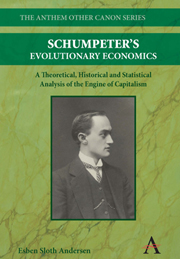 Schumpeter's Evolutionary Economics
Schumpeter's Evolutionary Economics Book contents
- Frontmatter
- Contents
- List of Figures
- List of Tables
- Preface
- Acknowledgements
- Abbreviations
- 1 Introduction
- I Equilibrium Economics and Evolutionary Economics
- II The Evolutionary Trilogy
- III Works in Progress
- 10 Schumpeter and the Years of High Theory
- 11 Evolutionary Analysis and the History of Economics
- 12 Beyond Schumpeter's Evolutionary Economics
- Appendices
- Schumpeter's Works
- Other References
- Index of Schumpeter's Works
- Index of Persons
10 - Schumpeter and the Years of High Theory
from III - Works in Progress
Published online by Cambridge University Press: 05 March 2012
- Frontmatter
- Contents
- List of Figures
- List of Tables
- Preface
- Acknowledgements
- Abbreviations
- 1 Introduction
- I Equilibrium Economics and Evolutionary Economics
- II The Evolutionary Trilogy
- III Works in Progress
- 10 Schumpeter and the Years of High Theory
- 11 Evolutionary Analysis and the History of Economics
- 12 Beyond Schumpeter's Evolutionary Economics
- Appendices
- Schumpeter's Works
- Other References
- Index of Schumpeter's Works
- Index of Persons
Summary
Schumpeterian unfinishedness
It is tempting to end the present book on Schumpeter's evolutionary economics by solving two related tasks. The first task is to provide a systematic summary of Part II's rather complex presentation of his evolutionary trilogy. The second task is to summarise and evaluate the “standard criticisms” (Lange, 1941, 192) that have been raised against the different elements of his work. The combined solution of the two tasks would serve to continue a literature that was initiated immediately after Schumpeter's death. At that time, Richard Clemence and Francis Doody published a small book called the The Schumpeterian System. This book, which is largely based on Cycles, gives a condensed and relatively systematic presentation of Schumpeter's core contributions. His two former students also had the ambition of confronting a situation where
“a set of ‘standard criticisms’ has grown up that not only discourages investigation of the [Schumpeterian] model but threatens to become a part of the folklore of economics. … The Schumpeterian System is an imposing analytical machine. It is large enough; it has sufficient power; and it is made of the best materials. But will it work? So its inventor claims, but others are less confident. Indeed, it is said that there are serious flaws in all parts of the engine, and that it can never be made to operate. Let us examine the System for ourselves, and see what conclusions we can reach.”
(Clemence and Doody, 1950, 5–6)- Type
- Chapter
- Information
- Schumpeter's Evolutionary EconomicsA Theoretical, Historical and Statistical Analysis of the Engine of Capitalism, pp. 297 - 326Publisher: Anthem PressPrint publication year: 2009


